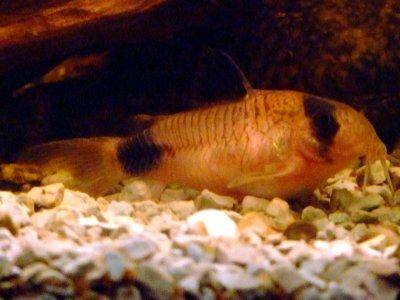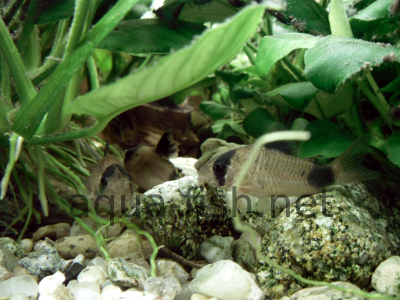Panda Corydoras (Corydoras panda): Complete Guide to Breeding, Feeding, and Aquarium Setup
Quick Navigation
Brief Description
This page is dedicated to caring for Panda Corys, providing answers to all questions from both beginners and experienced aquarists. If you don’t find the information you need here, feel free to submit your questions using the form at the bottom of the page. You can also check out this page: Panda Cory - Corydoras panda Profile, which includes links to similar fish. For more options, visit our search page to explore other Corydoras species in our database!
Basic Requirements and Ideal Conditions for Panda Corys
Panda Corys (Corydoras panda) are small, peaceful fish native to the Rio Pachitea in Peru. They thrive in clean, stable, and well-decorated aquariums with plenty of cover and soft substrate.
Water Parameters
- Temperature: 22 – 28°C (71.6 – 82.4°F)
- pH: 5.8 – 7.8
- General Hardness (dGH): 4 – 18 °N
- Filtration: Strongly recommended – Panda Corys are sensitive to unstable water conditions
Tank Size and Grouping
- Minimum group size: 6 (ideally 10–15 for natural behavior)
- Minimum tank size: 10 gallons (37 liters) for a group of 10
- Important: Never keep Panda Corys alone – they are social and require a group to thrive
Substrate and Decoration
- Substrate: Soft sand or very fine gravel (max 3–4 mm)
- Safety: Avoid sharp edges – their barbels are delicate and easily damaged
- Hiding places: Include caves, driftwood, and dense planting for cover and comfort
Aeration
Panda Corys may swim to the surface for air if oxygen levels are too low. Ensure proper aeration using air stones or filters that promote surface agitation.
Recommended Plants
- Echinodorus angustifolius
- Echinodorus amazonicus
- Cabomba furcata
- Echinodorus bleheri
- Mayaca fluviatilis
- Anubias nana and other Anubias sp.
- Ludwigia inclinata
Proper Diet for Panda Corys
Feeding Panda Corys a varied and high-quality diet is essential for their health, coloration, and activity levels. These bottom dwellers spend most of their time foraging, so be sure to offer sinking foods that reach the substrate.
✅ Recommended Foods
- Brine shrimp (live or frozen)
- Tubifex worms
- Black and white mosquito larvae
- Microworms
- Tablet food, pellets, and granules
- Flakes that settle to the bottom
❌ What They Don't Eat
- They do not consume fish waste or feces
- They do not eat live plants
Feeding Tips
- Feed twice a day in small portions they can finish in 1–2 minutes
- Smaller, frequent meals promote active foraging and cleaner tanks
- Do not overfeed – they can gain weight quickly
Feeding Time
Panda Corys are more active in the evening, so it's best to feed them later in the day when they are most likely to be foraging.
Special Note for Breeding
During breeding, offer frozen bloodworms and white worms to support energy levels and encourage spawning behavior.
Body Characteristics and Sexing
Appearance
Panda Corys have a sandy or cream-colored body with distinctive black markings that resemble a panda bear:
- Black band across the eyes
- Black stripe on the tail base
- Black dorsal (top) fin
- All other fins are transparent or lightly colored
♂️ vs ♀️ Sex Differences
Sexing Panda Corys is relatively easy once they mature. Here are the key differences:
- Females: Broader and more rounded bodies, especially when carrying eggs
- Males: Slimmer and more streamlined; often seen chasing females during breeding periods
Observing your fish during feeding or swimming can help you identify sex differences more easily. Females may appear noticeably plumper even outside the breeding season.
Breeding Your Panda Corys
Breeding Panda Corydoras is quite similar to other Cory species and can even happen spontaneously. However, to increase your chances of success, it helps to recreate their natural breeding conditions.
Breeding Triggers and Preparation
- Diet: Offer live or frozen foods like brine shrimp, bloodworms, or larvae to condition the fish for spawning.
- Water Changes: Perform partial water changes every other day to simulate the rainy season.
- Temperature Drop: Lower the water temperature gradually from 26°C (78°F) to around 22°C (71°F) to mimic seasonal changes.
Important Notes
- No tank mates during breeding: Other fish may eat the eggs or fry.
- Don’t move your Corys: If needed, move tank mates instead to avoid stressing the Panda Corys.
- Breeding ratio: A 1:1 male-to-female ratio is best, but 2 males to 1 female can also work.
Egg Laying and Care
Panda Corys usually lay 10–15 eggs at a time, often early in the morning. Eggs are laid on the glass or the underside of plant leaves.
To protect the eggs:
- Use a credit card or razor blade to carefully remove eggs from surfaces.
- If laid on a leaf, cut the leaf and isolate it.
- Transfer the eggs to a separate container placed inside the tank to maintain consistent water parameters.
Removing the eggs is essential because adults (and other fish) often eat them if left in the tank.
Caring for Panda Cory Fry
Once the eggs hatch, the fry will rely on their yolk sacs for nourishment and should not be fed immediately.
First Few Days
- Yolk sac absorption: Takes approximately 2–3 days, sometimes up to 5 days.
- No feeding required during this time.
First Foods After Yolk Sac Is Absorbed
When the fry are ready to eat, offer the following foods:
- Daphnia
- Newly hatched brine shrimp
- Microworms
Feed in small amounts several times per day, ensuring the water remains clean to prevent bacterial outbreaks.
Growth and Development
- At 3 weeks old: Fry can begin eating the same diet as adult Panda Corys in smaller portions.
- At 1 month old: Fry reach approximately 1 cm (0.39 inches) in length.
Behavior of Fry
- Fry are more solitary than adults and do not school.
- They often graze on algae that grows on glass, rocks, and substrate.
Consistent care and good water quality will ensure a high survival rate and healthy growth for your young Panda Corys.
Suitable Tank Mates for Panda Corys
Panda Corydoras are peaceful, social bottom-dwellers that thrive in community aquariums with equally non-aggressive fish. When choosing tank mates, prioritize species that share similar water parameters and gentle behavior.
✅ Recommended Tank Mates
- Tetras: Neon Tetras and other small peaceful tetras
- Other Corydoras species: Peaceful and compatible companions
- Catfish: Bristlenose Plecos (Ancistrus), Aspidoras
- Cichlids: Angelfish, Discus, Blue Rams
- Labyrinth fish: Bettas, Dwarf Gouramis
- Loaches: Most peaceful varieties, such as Yoyo Loaches
⚠️ Important Considerations
- Always avoid aggressive or fin-nipping species.
- Ensure tank mates tolerate the same water temperature and pH range.
- Do not overcrowd the aquarium—Panda Corys are sensitive to water quality changes.
If you're unsure whether a certain species is compatible with your Panda Corys, feel free to ask us at the bottom of this page!
Photo Gallery: Panda Corydoras in Action
Explore close-up images of Panda Corys in planted tanks. These photos highlight their appearance, natural behavior, and peaceful nature.

Corydoras panda resting in a well-planted community tank.









